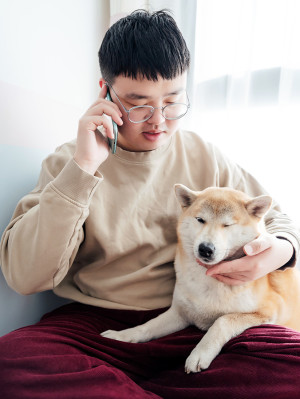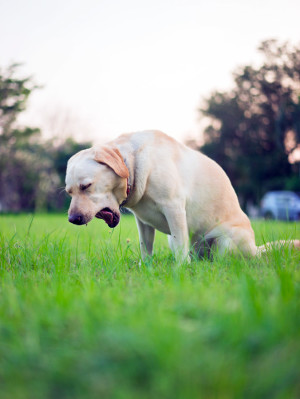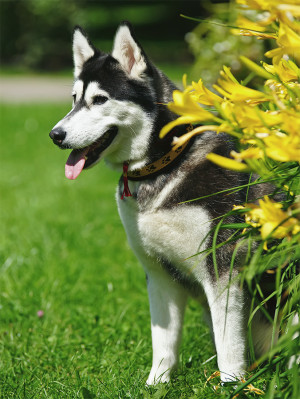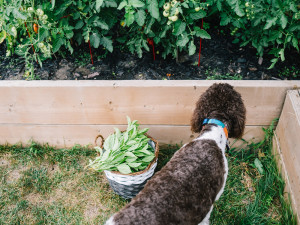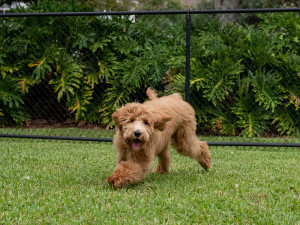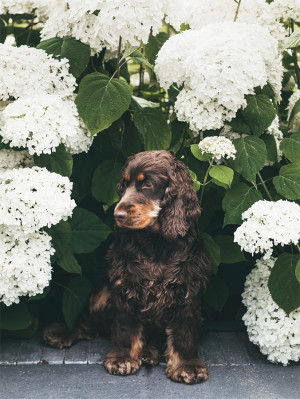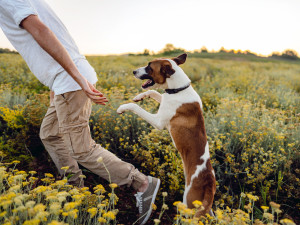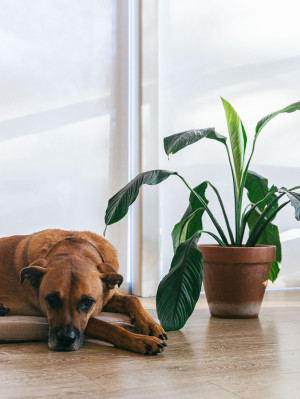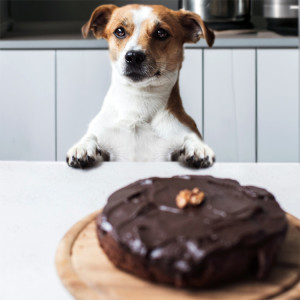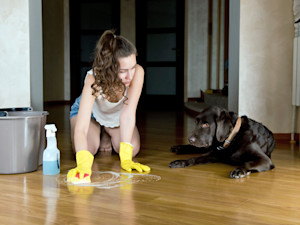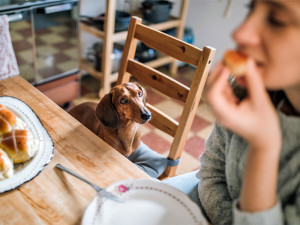Are Daffodils Poisonous to Dogs?
They might be nice for us, but not so nice for our pooches...

Share Article
In this article:
How poisonous are daffodils to dogs?opens in a new tab Are daffodil bulbs poisonous to dogs?opens in a new tab What makes daffodils toxic to dogs?opens in a new tab How to identify a daffodilopens in a new tab Symptoms of daffodil poisoning in dogsopens in a new tab Daffodil poisoning causesopens in a new tab Daffodil poisoning quantitiesopens in a new tab Length of daffodil poisoning symptomsopens in a new tab Daffodil poisoning diagnosisopens in a new tab Daffodil poisoning treatmentopens in a new tab How to keep dogs away from daffodilsopens in a new tab
Daffodils are a familiar sight when the seasons change and the natural world begins to bloom, popping up in parks, gardens and woodlands bringing a splash of vibrant yellow colour among a carpet of green foliage. However, if you’re a dog parent, you might be wondering: are daffodils poisonous to dogs? Do you need to be concerned if your pooch wants to go bounding through the brush whilst frolicking with their doggie pals? The short answer is, unfortunately, yes. Here’s what you need to know to keep your dog safe in springopens in a new tab.
Are daffodils toxic to dogs?
The lovely spring plant that dazzles, generally in spring, with its vibrant trumpet flowers are part of the Narcissus species. All parts of the plant are deemed poisonous to dogs, especially the bulbs, which contain the highest concentrations of toxinopens in a new tab.
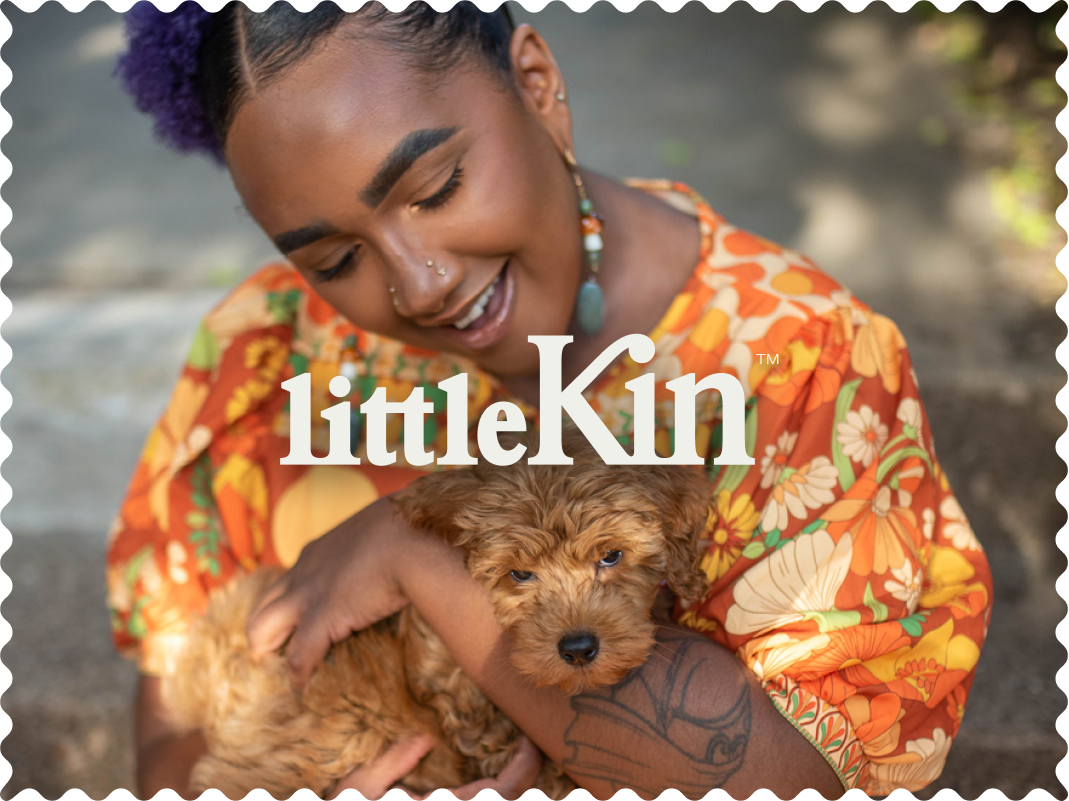
littleKin™ is Kinship’s home just for puppy and kitten parents. Bop over to check out expert advice, new pet tools, and special deals—all curated for your newest family member.
opens in a new tabHow poisonous are daffodils to dogs?
There is no rule to know how your pooch may react if they were to ingest some of the daffodil plant so seeking veterinary advice immediately is advised, even if the symptoms seem mild. However, if they choose to eat the bulbs then more serious effects may be witnessed.
Are daffodil bulbs poisonous to dogs?
The outer layer of the daffodil bulb contains calcium oxalate crystals, which is an irritant and can affect your dog’s mouth causing severe tissue irritation. So, even if your dog was to chew the bulb but not ingest it, they still may show clinical signs of poisoning symptoms. Ingestion of the bulb may lead to severe gastrointestinal signs, and at worst, cause cardiac and respiratory issues.
Can daffodils kill dogs?
To have a fatality from ingesting a daffodil is rare, however, it can happen if your dog ingests a large amount – if your dog was to eat a large amount of daffodil bulbs (15g or more) then the most serious signs may be seen. Smaller dogs, puppies or dogs that have other underlying health issues may be more susceptible to developing more serious effects.
What makes daffodils toxic for dogs?
All parts of the daffodil plant – including its bulbs, stems, leaves, and flowers, with the most concentration appearing in the bulbs – contains lycorine and calcium oxalate.
Lycorine is an alkaloid that can cause vomiting, diarrhoea, abdominal pain and drooling in dogs.
Calcium oxalate crystals can irritate the mouth and digestive tract, leading to symptoms such as drooling, swelling and discomfort.
How to identify a daffodil
Daffodils are one of the most recognisable plants of spring, often growing in clusters that spread easily across grassy areas. Before we know it, gardens, paths and parks are full of the vibrant yellow hue. Nice for us, but not so nice for our four-legged family members.
A daffodil is characterised by its tall, dark green stem and narrow, strap-like leaves that grow around the stem. At the top of the stem sits the daffodil’s recognisable trumpet-shaped floweropens in a new tab, which is surrounded by a ring of six petal-like tepals.
Most commonly, daffodils are bright yellow, but they can also come in various colour combinations. Their petals are typically white or yellow, while the trumpet (or corona) at the centre can range in colour from yellow and white to orange or even pink, depending on the variety.
Symptoms of daffodil poisoning in dogs
The following symptoms have been recorded with daffodil poisoning:
In mild cases:
vomiting
diarrhoea
irritation to the mouth
drooling
abdominal discomfort
lethargy
pyrexia (high temperature)
In severe cases:
staggering
hypothermia (low body temperature)
hypotension (low blood pressure)
cardiac irregularities
respiratory depression,
tremors
collapse
unconsciousness
coma
How do dogs get daffodil poisoning?
Dogs can get daffodil poisoning in several ways, but the most serious symptoms usually occur when a dog eats the bulbs. The bulbs contain the highest concentration of toxic compounds, including lycorine, making them particularly dangerous if dug up and chewed. This is especially a risk for dogs that love to explore with their mouths or dig in the garden.
That said, chewing or ingesting any part of the daffodil plant – be it the leaves, stems, or flowers – can also cause toxicity. In addition to ingestion, brushing up against daffodils can lead to skin irritation in some dogs. The calcium oxalate crystals in the plant sap can irritate the skin, causing redness, itching or discomfort. This can be particularly problematic for dogs with sensitive skin or those that repeatedly come into contact with the plants.
How many daffodils does your dog need to eat to get sick?
The severity of daffodil poisoning in dogs depends less on the quantity eaten and more on which part of the plant has been ingested. While all parts of the daffodil are toxic, the bulbs contain the highest concentration of harmful substances, such as lycorine and calcium oxalate crystals.
Even small amounts can cause symptoms, but the level of risk also changes depending on the size of the dog and the amount consumed. For example:
Small dogs (eg, toy or miniature breeds) may experience noticeable symptoms from chewing just a few leaves or flowers, or ingesting even a small portion of a bulb.
Larger dogs might tolerate small amounts of the plant without severe effects but are at significant risk if they eat substantial quantities, particularly of the bulbs.
If a dog consumes around 15 grams or more of a daffodil bulb, more serious symptoms, such as severe vomiting, diarrhoea or even heart arrhythmias, may occur.
How long daffodil poisoning symptoms last in dogs
Acting swiftly is always key if you think your dog has ingested anything toxicopens in a new tab. Treatment will often be supportive with rehydration being key, especially if vomitingopens in a new tab and diarrhoea is persistent. Depending on the symptoms and the amount consumed, it could only last a few hours, however supportive care for a few days may be required in more serious cases.
How vets diagnose daffodil poisoning in dogs
If you have witnessed your dogs eating or chewing a daffodil plant it is vital you share this with your vet – when, how much and what part of the plant ingested will help the veterinary surgeon when navigating a treatment plan.
The dog will be thoroughly examined including vital signs (heart rate, respiratory rate and temperature). A blood sample may be taken to check liver and kidney function as well as any potential electrolyte imbalances.
How to treat daffodil poisoning in dogs
If ingestion was recent (within two hours) then your vet may suggest making your pooch vomit to bring up the contents of their stomach (lovely). Activated charcoal will be administered to help absorb any toxins.
Anti-sickness medication may be given as supportive management as well as intravenous fluids to help with any dehydration and continuing fluid loss through persistent severe vomitingopens in a new tab and diarrhoeaopens in a new tab. In cases where large amounts have been ingested gastric lavage may be needed to ensure all toxic plant material is removed.
Can you treat daffodil poisoning at home?
Many toxin ingestions can overlap their symptoms so it is vital to ensure that you are fully aware of what is in your garden whether that be other potentially poisonous plants or chemicals. Always speak to your vet first, but if your dog’s signs are quite mild then keeping them at home for monitoring, warmth and TLC may be enough until the effects wear off.
If you are unable to speak to a veterinary surgeon or get to a clinic, the Animal PoisonLineopens in a new tab (01202 50 9000) offers around-the-clock advice to pet parents concerned about their pets ingesting something toxic. Calls cost between £35 – £45 per phone call for the service, run by Veterinary Poisons Information Service (VPIS), however 80 percent of vets are members of VPIS and would make the same call from the vet clinic, so you are saving a step.
How to keep dogs away from daffodils
When out walking your pooch, always ensure you are aware of where your dog is. Having a strong recall is vital especially if you see any imminent danger ahead (hello daffodils) – even if you have to pop them back on the lead when you pass the area.
Always be vigilant in your own gardenopens in a new tab and if you notice any daffodils erupting it may be better to see if you can cordon that areaopens in a new tab off or even dig up the plants. Alternatively you may have to block off larger areas of the garden until the plants have bloomed and died back.
Final thoughts: are daffodils poisonous to dogs?
Yes, all parts of the plant can be poisonous with the most serious signs coming from the bulbs.
Frequently asked questions: are daffodils poisonous to dogs?
Are dogs allergic to daffodils?
Dogs are not allergic to daffodils in the sense of having immune-mediated allergic reactions, like some people do with pollen or certain foods. However, daffodils contain substances that can be harmful if ingested. The plant, including its bulbs, stems, leaves, and flowers, contains lycorine and calcium oxalate.
These compounds make daffodils toxic to dogsopens in a new tab, so it’s essential to prevent your four-legged friend from chewing on or ingesting any part of the plant. While they may not cause a classic allergic reaction, the risk of toxicity is significant and should not be overlooked.
What parts of a daffodil are toxic to dogs?
All parts of the plant are toxic including the bulb, stem, leaves and flower petals.
What happens if a dog eats daffodils?
Signs may be mild with some gastrointestinal symptoms but in more serious cases it can cause worse clinical symptoms such as cardiac and respiratory issues.
How do you treat bulb poisoning in dogs?
Treatment is often supportive providing intravenous fluids, anti-nausea medication and activated charcoal.
What are the most poisonous plants for dogs?
Bluebells, daffodils, yew, foxglove, rhododendron, azalea, lily of the valley, deadly nightshade, hemlock and laburnum are considered some of the most toxic plants to dogs in the UKopens in a new tab.
Resources
Crawley, Michael J. “ Daffodil Cultivars by Colour.opens in a new tab” Identifying Daffodils, Botanical Society of Britain and Ireland, Jan. 2023.
“ Wild Daffodil.opens in a new tab” The Wildlife Trusts. Accessed 27 Jan. 2025.
“ Are Daffodils Poisonous to Cats and Dogs?opens in a new tab” Animal PoisonLine, 1 Mar. 2018.
Akram, Muhammad Nadeem, et al. “ Effect of Bulb Age on Alkaloid Contents of Narcissus Pseudonarcissus Bulbs.opens in a new tab” South African Journal of Botany, Elsevier, 27 Aug. 2020.

Zoe Blake RVN, ISFMCertFN / AdvCertFB, MISAP
Zoe is a registered veterinary nurse and has been in the profession for over 30 years. She enjoys educating pet owners on all aspects of their care and regularly writes to support her work. When she is not chatting animals, she can be found running around the tennis court or exploring the countryside with her rescue dog, Dylan.
Related articles
![Man with glasses on the phone with dog on his lap]() opens in a new tab
opens in a new tabWhat to Do When Your Dog Eats Something Toxic
So Fido has been in your chocolate stash... here’s what to do
- opens in a new tab
Are Hydrangeas Toxic to My Dog?
You can live your best Cotswolds cottage life. Just keep your dog away from this plant
- opens in a new tab
Are Peace Lilies Toxic to Dogs?
Keep your pup far away from the toxic plant
- opens in a new tab
Can Dogs Eat Chocolate?
Keep those chocolate bunnies far away from your pup this Easter (and always)
![Woman with brown hair on hand and knees with yellow cleaning gloves on, cleaning the floor whilst a black Labrador watches on]() opens in a new tab
opens in a new tabPet-Safe Cleaning Products
Because we have to look after the four-legged family members, too
- opens in a new tab
Can Dogs Eat Hot Cross Buns?
Sometimes ‘sharing is caring’ isn’t the best advice
